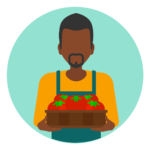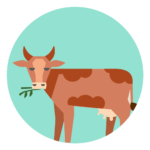
In advance of Augsburg College’s upcoming event on February 21, “Conversations on the Creative Economy: Global Food In A Farm-To-Table World,” Morgan Mercer sat down with panelist Mike Robach to examine how Cargill approaches global food security.
Every year, there is a great migration. It takes semi-trucks, trains, barges, and even mammoth ships that cross the ocean. You may not realize it’s happening, but if this mass movement ever stopped, you’d notice it immediately.
Your grocery store would look different; your breakfast plate would certainly need to change; and you could forget about the daily diet you’re used to eating.

Think about the orange sitting on your kitchen counter—the one you planned to eat as a mid-morning snack. It wasn’t grown in Minnesota. Instead, it logged some serious travel miles to get to you. And that morning cup of coffee or tea you insist on drinking to start each day? More miles. While many Minnesotans like to shop close to home, that’s not an option for many of the food staples we now consider mandatory.

Choice requires transportation. Today, more than 20% of food crosses borders, but that number is only set to increase as the global community faces a new challenge in the decades ahead: to successfully feed a population that will grow from nearly 7.5 billion people to more than 9 billion people by 2050.
For Minnesota, that not only means importing food that doesn’t easily grow in our hardy climate, but also shipping out crops that our farmers can grow in abundance.

To sustainably feed a global population in the midst of changing climates and diets, the agricultural industry must plant crops in the places where they are best suited to grow productively says Mike Robach, Cargill’s vice president of corporate food safety, quality, and regulatory affairs. For Minnesota, that means soybeans, corn wheat, and even meat, like turkey.
“These are foods that drive the global food system and Minnesota is sitting right there in the middle.”
“These are foods that drive the global food system and Minnesota is sitting right there in the middle,” says Mike, who has helped Cargill tackle solutions to global food security and sustainability for more than 13 years.
“We produce a lot more than we could ever eat. We need strong agricultural markets and access to export markets in order for Minnesotans to thrive. We’re part of the fuel that is driving the global food supply network.”

For Mike and companies like Cargill, global food security is about more than eliminating hunger and making sure everyone has access to enough calories. For them it’s about something much grander: freedom.
Supporting sustainable farming worldwide not only builds local economies, but it also raises farmers out of poverty, increases food safety, and protects the environment.
Since 2010, global food companies have trained million of farmers around the world.

These companies help cocoa farmers in Ghana and Cote d’Ivoire increase their production and trade their beans at higher prices in international markets year round. This means farmers can afford to send their children to school. In India, global food companies teach farmers how to build more efficient and safe distribution systems to reduce waste. Before that, upward of 50% of crops rotted in fields because farmers didn’t have the infrastructure in place to get fruits and vegetables to the market in time.

While countries like these may seem far away from Minnesota, they’re not. We rely on each other.

Our crops feed their animals and become cooking oil that people use to cook with around the world. Their crops sit in our coffee pots, and put fruits and vegetables on our countertops. Food ties us all together. Global food security means their success is our success.

C O O L F A C T S

Globally, if female farmers had the same access to resources as men, the number of hungry people in the world could drop by up to 150 million people.

Nearly 40% of the global population works in agriculture to make a living, making that industry the single largest employer in the world.

Cargill is exploring technologies that will allow it to increase the nutritional quality of crops that are traditionally grown in Africa, like the cassava plant. Using gene insertion, scientists can introduce additional vitamins to the basic root crop and then easily propagate it in local communities.

Typically, dairy farmers in India collect 10 liters of milk per day from their animals. To raise the national average, Cargill partnered with a local farmer to improve his animal husbandry skills. Following the training program his animals began to produce 36 liters of milk per day.

Seafood is the largest source of animal protein in people’s diets worldwide. To meet the growing demand, nearly 62% of seafood will be farm-raised by 2030. To prepare for this, Cargill announced it will build a $10.5 million Cargill Innovation Center in Chile that focuses on aqua nutrition and disease prevention. This new facility will be able to conduct nearly five times more studies than before and increase the global capacity for fish health research by 30%.


On February 21, join Chris Farrell from MPR at Augsburg College as he interviews leaders working on food security and sustainability.
This discussion will examine how leaders in the food and agriculture sector approach issues such as food security, public health, animal welfare, biodiversity, and environmental sustainability.
![]()
Guests include:
Mike Robach
Vice President of Corporate Food Safety, Quality, and Regulatory Affairs at Cargill
Jessica Hellmann
Director of the Institute on the Environment at the University of Minnesota
Dr. Ruth Petran
Vice President, Food Safety and Public Health at Ecolab Inc
This presentation is FREE and open to the public.
Sponsored by GREATER MSP and the Bush Foundation. Presented by the Strommen Center for Meaningful Work at Augsburg College in association with Minnesota Public Radio.
Story created in partnership with the Strommen Center for Meaningful Work at Augsburg College.
Contributors

